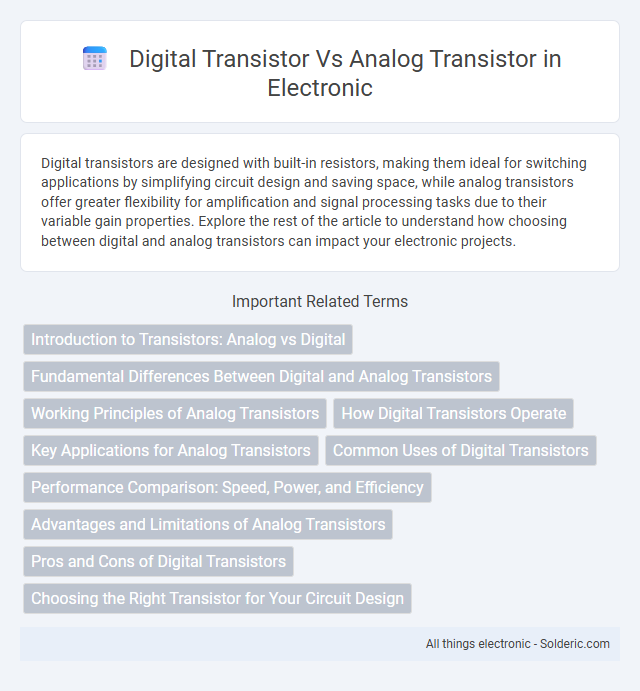Digital transistors are designed with built-in resistors, making them ideal for switching applications by simplifying circuit design and saving space, while analog transistors offer greater flexibility for amplification and signal processing tasks due to their variable gain properties. Explore the rest of the article to understand how choosing between digital and analog transistors can impact your electronic projects.
Comparison Table
| Feature | Digital Transistor | Analog Transistor |
|---|---|---|
| Definition | Integrated transistor with built-in resistors, designed for digital logic circuits. | Basic transistor used to amplify or switch analog signals. |
| Function | Switching with predefined input thresholds. | Signal amplification and switching with continuous input variation. |
| Components | Transistor plus internal resistors. | Single transistor device without integrated resistors. |
| Usage | Digital circuits, logic gates, and microcontroller inputs. | Analog circuits like amplifiers, oscillators, and signal modulators. |
| Input Type | Digital signals (0 or 1 states). | Continuous analog signals. |
| Ease of Use | Simpler integration due to built-in resistors. | Requires external components for biasing and gain control. |
| Cost | Typically slightly higher due to integrated components. | Generally lower cost but requires additional passive components. |
| Performance | Optimized for fast switching and digital performance. | Optimized for linear amplification and signal fidelity. |
Introduction to Transistors: Analog vs Digital
Analog transistors continuously amplify or switch electrical signals by responding to varying input voltages, making them essential for signal processing and amplification in analog circuits. Digital transistors integrate resistors within the package, simplifying switching operations by enabling direct interface with logic-level inputs for digital circuits. Understanding these differences helps you select the right transistor type to optimize performance in your electronic designs.
Fundamental Differences Between Digital and Analog Transistors
Digital transistors integrate a built-in resistive bias network, allowing them to switch on and off digitally with precise thresholds, while analog transistors operate continuously to amplify varying current or voltage signals. Analog transistors provide linear amplification essential for analog signal processing, whereas digital transistors function primarily as switches in digital circuits. Understanding these fundamental differences enables you to select the right transistor type for digital logic implementation or analog amplification tasks.
Working Principles of Analog Transistors
Analog transistors operate by continuously varying the current flow between the collector and emitter terminals in response to changes in the base current, enabling precise amplification of analog signals. The transistor functions as a current-controlled current device, where small input variations cause proportional output changes, critical for analog circuit applications such as amplifiers and oscillators. Understanding the analog transistor's working principle involves analyzing the transistor's operation in active, cutoff, and saturation regions to achieve linear signal amplification.
How Digital Transistors Operate
Digital transistors operate by integrating a built-in resistor on the base terminal, enabling simplified switching without the need for external resistors. Their operation is optimized for digital signals, allowing rapid on/off switching controlled directly by logic-level input voltage. This integration improves circuit design efficiency and reduces component count in digital electronic applications.
Key Applications for Analog Transistors
Analog transistors are essential in amplifying analog signals for audio devices, radio frequency circuits, and power regulation systems. They enable continuous signal modulation in sensor interfaces, analog oscillators, and voltage regulators. Your electronic designs benefit from analog transistors when precise control of current and voltage is required.
Common Uses of Digital Transistors
Digital transistors are predominantly used in switching applications, signal amplification, and interfacing with microcontrollers due to their integrated base resistors, which simplify circuit design. They are favored in digital logic circuits, LED drivers, and relay drivers where precise on/off control is essential. Unlike analog transistors that handle continuous signal amplification, digital transistors excel in binary switching operations and noise reduction in digital electronics.
Performance Comparison: Speed, Power, and Efficiency
Digital transistors exhibit faster switching speeds due to integrated resistors that reduce propagation delay compared to analog transistors, which rely on external components. Power consumption in digital transistors tends to be lower since they operate efficiently at defined logic levels, while analog transistors handle continuous signal variations often resulting in higher power dissipation. Efficiency in digital transistors is optimized for switching applications, whereas analog transistors provide better linearity and signal fidelity, making them suitable for amplification and signal processing tasks.
Advantages and Limitations of Analog Transistors
Analog transistors offer precise control over continuous signals, making them ideal for amplification and analog signal processing applications. They provide high linearity and wide bandwidth but are limited by higher power consumption and susceptibility to noise compared to digital transistors. The analog transistor's performance can degrade in complex circuits due to thermal effects and signal distortion, restricting their efficiency in digital logic operations.
Pros and Cons of Digital Transistors
Digital transistors simplify circuit design by integrating a resistor network within the device, reducing the need for external components and enhancing switching speed, which benefits your projects requiring fast, efficient signal control. However, digital transistors can have limited flexibility compared to analog transistors, as their integrated resistors restrict parameter customization, and they may generate more heat under continuous operation. Choosing digital transistors improves compactness and ease of use but may sacrifice the fine-tuning and linear amplification capabilities offered by analog transistors.
Choosing the Right Transistor for Your Circuit Design
Selecting the right transistor for your circuit design depends on the application's switching speed, voltage, and current requirements. Digital transistors integrate resistors internally, simplifying circuit design and offering faster switching ideal for digital logic circuits. Analog transistors provide greater control and linearity, making them suitable for amplification and analog signal processing tasks.
Digital transistor vs Analog transistor Infographic

 solderic.com
solderic.com